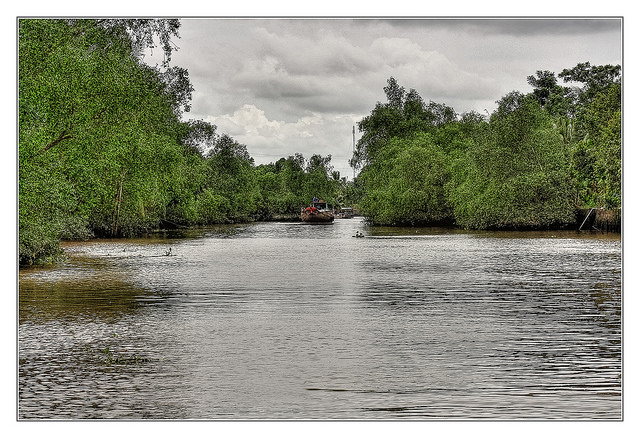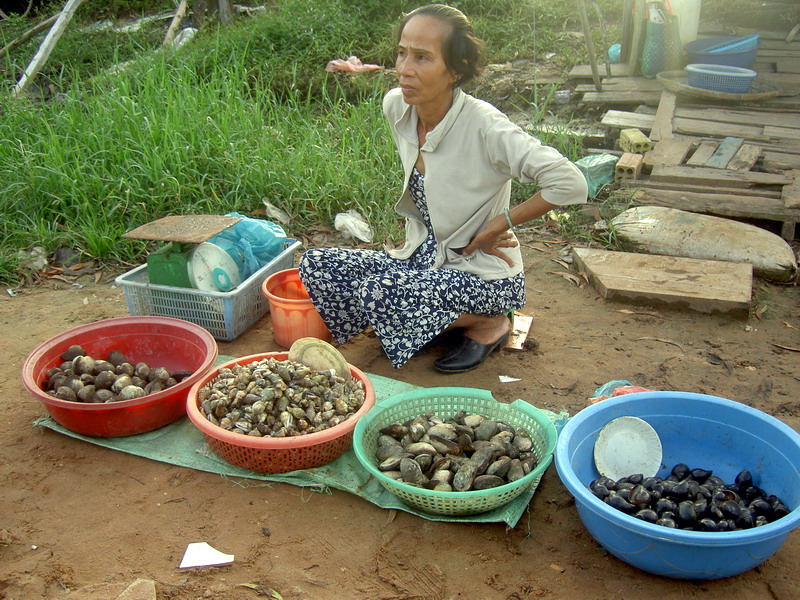Water resources in Vietnam are quite diverse, comprising both natural and artificial water bodies. The countries water resources are under increasing pressure from over-exploitation due to increased irrigation demand, urban and industrial development, as well as concentrated areas of increasing population. 1 Ensuring national water security is a top priority for the national government, who is attempting to respond to a range of trends and challenges in water management, with respect to:
- protecting domestic water resources from water quality decline;
- ensuring continued access to upstream trans-boundary water resources on which Vietnam is highly dependent;
- supplying clean accessible water services of sufficient quality and quantity to equitably meet human needs in Vietnam;2

A section of the Mekong River (Cửu Long River) in Cai Be, Tien Giang province, Southern Vietnam. Photo by Daniel Mennerich via Flickr. Licensed under CC BY-NC-ND 2.0.
Water Resources
In 2012, Vietnam was reported to have a total per capita renewable water resource availability of 9,560 m3, which was above the international average of 7,400 m3.3 However, as over 60% of water resources in Vietnam are sourced from upstream trans-boundary sources, the total internal renewable per capita water resource availability in 2012 had declined to 4,000 m3. This figure is predicted to further decline to 3,100 m3 by 2025, resulting in greater dependence on relationships with countries upstream of Vietnam.4
Vietnam’s primary water supply is sourced from surface flows captured by rivers and aquifers. The two largest of these flows come from the Red River and Mekong river, which are known locally as the Hong River and Cuu Long River, respectively. Groundwater resources have increasing importance in Vietnam as well, particularly in the mountainous regions to the north of Vietnam, the central highlands, as well as the Mekong Delta region, where dry-season water scarcity has become an important issue. The marine and coastal resources, within the territorial boundaries of the Socialist Republic of Vietnam are also important to Vietnam for the access to fisheries, ecosystem services from mangrove forests and transportation. In recent years, small amounts of snow has also been observed in mountainous areas in the north.5
Water resources in Vietnam
Rivers / streams over 10km in length | 3450 |
Total annual availability of surface water resources | 830 billion m3 |
Total annual availability of groundwater resources | 63 billion m3 / year |
Total water availability per capita | 9000 m3/year |
Number of reservoirs for hydropower and irrigation | 2900 |
Total reservoir capacity | 28 billion m3 |
Number of planned reservoirs | 510 |
Total volume of planned reservoirs | 56 billion m3 |
Total annual national water consumption (all uses) | 81 billion m3 |
Source: Department of Water Resources Management, Vietnam. These figures are current for the year 2015.
Of increasing importance in Vietnam is the distribution of water resources to meet the needs of ecosystems, as well as fulfilling human demands for water. The 16 major river sub-basins in Vietnam, 60% are concentrated around the Mekong Basin and 16% from Thai Binh Basin.6 Annual rainfall ranges from 700-5,000 mm in Vietnam. The number of rainy days per year is highly variable, ranging from 60 to 200. This is unevenly distributed.7 Sloping terrain plays an important role in water distribution in Vietnam with northwest to southeast axis concentrates surface water in the southeast, where all major river basins are located, leaving the more mountainous areas in the north, with less available surface water. For example, despite the significant volume of water resources in Vietnam, some coastal areas in Quang Binh and Binh Thuan provinces experience arid conditions, where soils are subject to local desertification. In these provinces about 419,000 ha of land has been affected along with 43,000 ha in the Mekong Delta region. 8
Water Resources in Vietnam. Map created by ODV, view more water resources datasets on Map Explorer.
The need for Integrated Water Resources Management
In Vietnam, the Law on Water Resources (1998, revised in 2012) is used as the basis for water governance in Vietnam, including the use of surface water, rainwater, groundwater and sea water. However, a range of factors, such as deforestation, mining, hydro-power dam construction, and climate change significantly impact both the quality and quantity of water resources available to Vietnamese people and their usefulness.9
The law makes provisions for the National Water Resources Council (NWRC) and local river basin organizations (RBO’s) in major basins to manage these issues across different government sectors in Vietnam and protect water resources in line with the Law on Environmental Protection (2005). However, in 2013, the water sector was reported to still be affected by fragmented governance and poor co-ordination. Furthermore, while water pricing has been implemented in Vietnam, it is under-valued and does not effectively encourage its efficient use, particularly by agriculture sector, which accounts for 82% of water use in the country.10 This has broader implications when considering trade-offs, regarding the full range of human needs for water and meeting the UN Sustainable Development Goals (SDGs).
Water Sanitation and Hygiene
In 2016, Vietnam’s population had reached 92.7 million people, which means that although significant improvements in the provision of water supply, sanitation, and hygiene services to the population have been made, substantial numbers of people still lack access to basic services. For example, in 2015, 8.2 million people still lacked access to ‘basic’ access to a water supply that does not involve more than a 30 minute return journey to access clean water and 20.3 million people lacked access ‘basic’ access to sanitation services, which enable separation from fecal waste.11
As Vietnam has a higher population density than other Mekong countries, the volume of untreated wastewater and fecal sludge that is produced represents a severe environmental and public health hazard, and a major challenge to manage given other water resource challenges such as water scarce regions, climate change and sea-level rise.12 For example, in 2015, to meet the Sustainable Development Goals, the total cost for Vietnam to extend ‘safely managed’ water supply services to those without this access was estimated to be US$1.39 billion; while to do the same for ‘safely managed’ sanitation services was estimated at $US898 billion.13
The coverage of WASH services in Vietnam is not equitable, affected by income level, ethnicity and geography. For, example, the following data visualization shows the contrasting water and sanitation service provision situation for urban and rural and rich and poor contexts. Regionally lower service levels are experiences in the Mekong Delta as well as northern and central highlands regions. The latter are home to a high proportion ethnic minority households.14
Chart created by ODV February, 2018. CC BY-NC-SA 3.0 IGO Source: Joint Monitoring Program for Water, Sanitation, and Hygiene (JMP) 2017. 15
Water and Gender
Gender and water are both cross cutting issues for the sustainable development of Vietnam. To comply with the Law on Water Resources, which states that water resources in Vietnam are owned by the Vietnamese people and are managed in a uniform manner by the state to ensure that all people benefit, it is important to consider the risks associated with the use of water and how they are experienced differently by different genders.16 For example, nearly 65% of households in Vietnam lack a water source on premises, and the role of collecting clean water is primarily a responsibility of women and girls, a figure which is 10% higher among ethnic minority households. Furthermore, although women are still the major domestic users of water, they are less likely to participate in decision making on either domestic or public water supplies.17

‘Sale of shell fish by the roadside, Phu Quoc’ by ntt (Own work) GNU Free Documentation License or CC BY-SA 3.0, via Wikimedia Commons
Furthermore women represent 60% of the agricultural work force, whilst owning only 9% of land resources, as well as representing 80% of aquaculture workers in Vietnam. As these roles are highly dependent on natural resources, women are exposed to the risks associated with climate change much more than men and thus are the most affected by natural disasters. Women are also often restricted by their domestic work from participating in decision making processes and voicing their knowledge about these impacts and have less capacity to address these problems because of this.18 These examples highlight the importance of understanding water scarcity problems in Vietnam from a gendered perspective if they are to be addressed effectively.
References
- 1. Department of Water Resource Management 2012. “Overview of Vietnam’s Surface Water”. Accessed January 2018.
- 2. National Center for Water Resource Planning and Investigation 2015. “Ensuring the Security of Water Resources for Sustainable Development”. Accessed January 2018.
- 3. Ministry of Natural Resources and the Environment 2011. “Water Resources in Vietnam – Weak and Lacking” Accessed January 2018.
- 4. Department of Water Resource Management 2012. “Overview of Vietnam’s Surface Water”. Accessed January 2018.
- 5. Ibid.
- 6. Department of Water Resource Management 2012. “Overview of Vietnam’s Surface Water”. Accessed January 2018.
- 7. Global Facility for Disaster Reduction and Recovery 2011. “Vietnam: Vulnerability Risk Reduction and Adaption to Climate Change”. Accessed February 2018.
- 8. Vietnam Association for the Protection of the Environment 2013. “Desertification and Climate Change in Vietnam”. Accessed February 2018.
- 9. Pech, S. and H. Ranamukhaarachchi 2013. “Water Governance Systems in Cambodia, Lao PDR, and Vietnam”. Accessed February 2018.
- 10. Ibid.
- 11. Joint Monitoring Program for Water, Sanitation, and Hygiene (JMP) 2017. “Estimates on the use of water sanitation and hygiene in Viet Nam”. Accessed February 2018.
- 12. Institute of Sustainable Futures 2011. “Vietnam: WASH Sector Brief” Accessed February 2018.
- 13. Hutton, G. and M. Varughese 2016. “The Costs of Meeting the 2030 Sustainable Development Goal Targets on Drinking Water, Sanitation, and Hygiene”. Accessed February 2018.
- 14. Institute of Sustainable Futures 2011. “Vietnam: WASH Sector Brief” Accessed February 2018.
- 15. Joint Monitoring Program for Water, Sanitation, and Hygiene (JMP) 2017. “Estimates on the use of water sanitation and hygiene in Viet Nam”. Accessed February 2018.
- 16. National Assembly of the Socialist Republic of Vietnam 2012. “Law on Water Resources”. Accessed February 2018.
- 17. United Nations in Vietnam 2016. “Women and the Sustainable Development Goals: Vietnam towards 2030”. Accessed February 2018.
- 18. Ibid.

